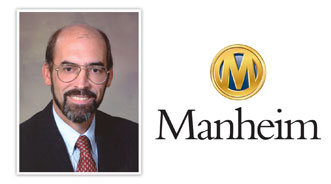Webb Pinpoints What Wholesale Price Fundamentals Are ‘Shouting’

Manheim chief economist Tom Webb cut through technical jargon analysts sometimes use and explained why the fundamentals for October’s wholesale price decline are “shouting.”
Webb indicated wholesale used vehicle prices (on a mix-, mileage- and seasonally adjusted basis) dropped in October after increasing in each of the previous four months. The development left the Manheim Used Vehicle Value Index reading at 122.3 for October, which represented a 0.3-percent increase from a year ago.
“Since the all-time high in May 2011, the Manheim Index has shown a pattern of each subsequent cyclical high being lower than the previous one, and each low lower than the earlier one,” Webb said.
“Technical analysts term such a pattern ‘a confirmation of trend.’ But we don’t need technical analysis to support the notion that the secular trend for wholesale prices is down — the fundamentals are shouting it,” he continued.
So what exactly is being shouted in the lanes nowadays besides prices by auctioneers and bid acknowledgements by ringmen? Webb elaborated when Manheim shared the latest index reading on Thursday.
“Most notably, there is the coming increase in wholesale supplies. That increase will be driven primarily by off-lease volumes, but higher supplies will also come from other commercial sources,” Webb said.
“And, in the short term, wholesale prices on a year-over-year basis will now begin to bump up against the inflated levels created by Hurricane Sandy in October 2012,” he continued.
“With respect to retail demand, we believe that the market will remain favorable for dealers, but that the impressive improvements achieved over the past two years will be hard to repeat,” Webb went on to say.
Looking deeper at the October, Manheim noticed pickup price climbed 5.3 percent year-over-year, an amount more than double the combined price lift produced by the other two segments that increased last month. While prices for compact cars edged up just 0.5 percent, prices for vans increased 2.7 percent.
Two other three vehicle segments posted marginal price decreases in October, as Manheim pegged the price drop-off for luxury cars at 0.9 percent and for midsize cars at just 0.1 percent.
Prices for CUVs and SUVs dipped the most last month as Manheim pegged the drop-off at 1.2 percent.
Recap of Used-Vehicle Sales Performance
Turning his attention to last month’s used-vehicle sales data, Webb indicated “overall growth continues and some segments sizzle.”
In October, total used unit retail sales rose 3.6 percent, resulting in a 3.5-percent year-to-date increase, according to CNW.
Within that total, Webb pointed out certified pre-owned sales rose 20.6 percent in October. Year-to-date CPO sales are 15.3 percent ahead of last year’s pace.
“Likewise, in the third quarter, the seven publicly traded dealerships groups posted their 17th consecutive quarterly increase in used unit retail volumes on a same-store basis,” Webb reiterated, a point he raised in a report Auto Remarketing published here.
“With off-lease volumes set to accelerate next year, franchised dealers should see higher volume again next year,” he continued.
“The key is what level of profit those sales will generate. To that end, it is promising that gross margins held steady in the third quarter after declining steadily over the past several years,” Webb went on to say.
New-Vehicle Sales Stabilize
Before getting into the number, Webb explained recent trends he believe have most influenced new-model sales data in recent months.
“Recently, a true monthly read of new-vehicle sales has been hampered by the pull-ahead of Labor Day sales into August, the payback for that in September, and then an October influenced by the government shutdown,” Webb said.
“Nevertheless, the annualized new-vehicle selling rate (on a three-month moving average basis) has begun to plateau in the 15.5 to 15.7 million range,” he continued.
Webb called the consensus forecast of slightly more than 16 million new-vehicle sales in 2014 “reasonable,” but he prefaced that potential.
Even if achieved, that would represent a much smaller percentage gain than what we posted in each of the past four years. The upward sales momentum has slowed,” he said.
“But pricing power has not slowed — and that’s even more important,” Webb went on to say. “Average transaction prices continue to rise as the result of lower net incentives, higher sticker prices, and the consumer’s desire for more heavily contented vehicles.”
Continue the conversation with Auto Remarketing on both LinkedIn and Twitter.


